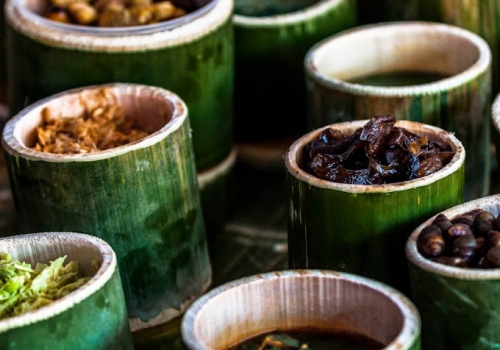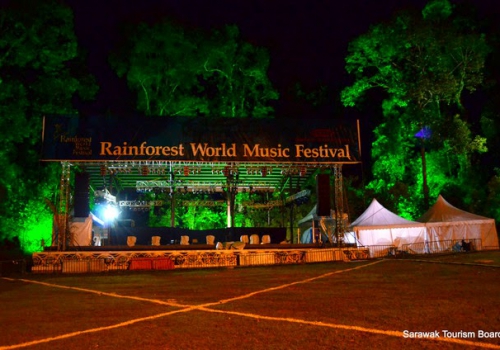September 5, 2019
From the Zulu warriors in South Africa, to the ancient Egyptians of North Africa, to the pilgrims of the Middle East or South America, beads have a presence in many cultures but the one commonality is that they have always been more than an eye-catching accessory. The story of the beads of Borneo is no exception.
For many cultures, they were a currency, or perhaps a sign of faith, a symbol of wealth or a family heirloom to be treasured for future generations. Whatever the purpose, the one consistency is that they are always a way of expression.
Sarawak in Malaysian Borneo has a unique relationship with the beads of Borneo. Although there isn’t any definitive evidence of when exactly the beads came to the region, there is evidence to suggest beads were first used in Borneo by visiting sailors for bartering. Back then, beads were made out of shells, teeth, bones and stones that were perforated and worn as ornaments.

Source: Sarawak Tourism Board
There are over 30 tribes in Sarawak and each tribe has its own way of adorning themselves with beads. Some of them use them as necklaces, others as beaded head caps or beaded skirts, others as bracelets or even rings. Beads would also be used as decorations during festivals or other big gatherings.
The baby carriers used by Orang Ulu women to carry their infants are adorned with beadwork and finishes made out of wild boar or leopard teeth. Apart from indicating status, the tingling of the Hawk’s bells and large beads attached to the upper rim of the carrier would soothe the toddler on long journeys through the rain forest.
Many of the antique beads of Borneo are hard to find now. There are a number of reasons for this. Historically, the beads were sometimes buried with their owners as part of their grave clothes, or as “grave gifts”, for the deceased to use in their long journey to the underworld.
As mentioned, beads were also used as currency, often traded with visiting sailors or lost in the sometimes devastating longhouse fires that could rip through 100 doors in less than an hour.
As beads were increasingly hard to come by and time became a precious commodity, modern day beads are mostly imported from Indonesia and China, according to Heidi Munan, Sarawak Museum’s curator of beads. However they are still influenced by the original beads of Borneo.
So while these new beads are still traded, they are no longer the currency of trade. And despite being mass produced, they are increasingly expensive yet have little of the character of the original beads. At the same time, the number of communities still making the beads of Borneo in the traditional manner is slowly diminishing.
Preserving the traditionality of beadmaking
However, the Lun Bawang community in Long Tuma village, Lawas, northern Sarawak continues to make ceramic beads the way they’ve always been made. Partly to generate income for the community but also because they want to keep the tradition alive and let everyone have the opportunity to wear the beads during traditional festivities.
The process begins with a group of five women wading almost nonchalantly into the crocodile infested waters of Pa’ Lawas river to find and dig up the smooth fine clay, which they call “tanah salit”.
The clay is taken to the village by hand, pounded and kneaded to the right consistency and shaped into tiny beads, roughly the size of a pea. The beads are then sun-dried, and strung up on wire loops and fired in a backyard bonfire.
Patricia Busak, daughter of Litad Muluk, who manages the ceramic beads centre, was interviewed by the Star newspaper some time ago and talked through the process, “It takes at least three pairs of hands to make just one bead: one to gather and process the river clay before shaping it into beads; another to paint the underglaze pattern; and a third to paint the glaze and arrange the beads in an electric kiln at the community-owned workshop in the village.”
She went on to say, “It’s very specialised; for instance, only three women in our group are skilled at rolling the beads. I can’t roll, but I’m good at painting the pattern.”
The Long Tuma women are the only beadmakers in Sarawak. Even though their business is thriving, the most important thing for the Lun Bawang community, is the opportunity to preserve their heritage.
“The kind of beads we have, how we string and wear them, give us our sense of identity as a Lun Bawang,” concludes Patricia in the interview.

Source: Borneo Talk, “The Glistening Beads Of Kampung Long Tuma”
Because beads have been used for so long and came from various parts of the world, the types of beads found in Sarawak vary. Here are a few examples of the types of beads you should look out for during your time in Sarawak and especially if you go to a festival.
Lukut Sekala
The Lukut Sekala beads are worn almost exclusively by members of the Kayan tribe. These beads serve as a symbol of longevity to the community. This is because the beads last for so long that they have become heirlooms, passed down through multiple generations.

Source: @taytayxanadu on Carousell
There are also the Lukut Bela Laba, which are considered male or female depending on whether the shape of the bead was long or flat. The beads are considered extremely valuable. These beads are often of great value to the Kayan.

Source: Rustic Borneo Travel, “Borneo Beads – Beautiful Status Symbols”
Ba’o Rawir
The Ba’o Rawir, or the drinking straw beads are created by Kelabit ladies. The Kelabit tribe originates from the Bario Highlands located in the northernmost part of Sarawak. The Kelabit people have a close association with the Lun Bawang tribe as they are geographically close to one another.
The Ba’o Rawir beads are used to create intricate designs on the Peta, a hat worn by Kelabit ladies. It is a status symbol which had the equivalent value of one buffalo in the old days when owning a buffalo was considered a sign of wealth. Today, an antique Peta hat made out of Ba’o Rawir can fetch up to RM 30,000 (US$ 7,150).

Source: Kelabit Wiki, “Peta”
Experience bead making yourself
Located in the north of Sarawak, the Long Tuma village is close to the Brunei border. The Ceramic Bead Centre holds workshops where you can learn how to make the beads and create your own piece. The Beads centre is currently managed by Litad Muluk and her daughter Patricia who is quoted above.
These women work the fields during the day and use the bead centre as an extra income stream while keeping the tradition alive. You can even see how this group of dedicated women put together beautiful pieces of jewellery.
And if you like what you see, you can support their efforts by purchasing beads from the souvenir shop.
Here is where it’s located:
Pusat Kraftangan Manik Seramik
Kampung Long Tuma, 98850 Lawas, Sarawak
Tel: +6013 565 6951
If you’re interested to learn more about the beading culture of Borneo, Heidi Munan’s book on Bornean beads is a highly recommended read. In it, she explains the historic significance of beads and how they transcend its mere aesthetic appeal.
You can also order beads online and support the Lawas bead community at the same time. These 3 online stores offer authentic products sourced from Sarawak:
Share





